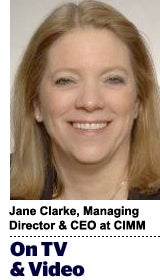“On TV And Video” is a column exploring opportunities and challenges in advanced TV and video.
Today’s column is written by Jane Clarke, managing director and CEO at the Coalition for Innovative Media Measurement (CIMM).
Smart marketers today are trying to understand the impact of their advertising across a fragmented ecosystem of platforms. In particular, we want to understand deduplicated reach and ROI of advertising by gaining access to cross-platform video viewership data and other forms of media data.
The premise is simple, in theory, yet, it’s much more complicated in practice because so many different sources own and house data. Publishers have app data, MVPDs have app data, marketers have their own site and app data, and on it goes. Current solutions from third-party measurement providers require complicated implementation of tags and SDKs.
Marketers want to stitch together a narrative about their brand’s performance using impression data from owned, earned and paid media. We desire access to common metrics across all data platforms. We want access to data – which resides within platforms and walled gardens, publishers and media companies and advertiser-owned digital properties – because this information will help reduce media waste and lead to better-informed business decisions.
There’s no existing arena for brands, agencies and publishers to contribute to, in aggregate, in return for access to a pool of shared data with common metrics for competitive intelligence and cross-publisher and cross-media ROI analyses. There should be.
What if there was a way to share standardized data – in a privacy-compliant way that protects valued customers and respects emerging regulations – while opening up a wealth of valuable data insights?
There is a very good reason to share our data. There’s even value in paying a fee to get our own data back, collectively, in its aggregated form, if it provides the intel needed to grow brands and businesses.
A precedent
There is a history of companies sharing their sales data into big databases to enable marketers to understand competitive sales and category trends.
It was once considered foolish to share first-party data like point-of-sale (POS data), but retailers recognized the benefit of having access to aggregated and audited transactional data to better inform business decision-making for planning, restocking and performance management against competitors.
Walmart was reticent to share its data, but even the largest brick-and-mortar retailer realized that it would deeply benefit from access to an aggregated national POS database, complete with information about its competitors.
Today retailers participate in and contribute their standardized data to large POS tracking systems. I foresee the same outcome for cross-media digital-impressions data. In the future, it will be standard practice to share data in return for a fuller picture of the competitive landscape.
We want competitive digital intelligence
We cannot continue in our own silos. Sharing audited and privacy-compliant data allows marketers and their agencies to make smarter, data-powered choices by helping to fill that gap in cross-platform measurement.
Advertisers also desire access to competitive digital ad spend data because the ways to collect that data currently are often inaccurate. We’re on the back foot when we lack credible insight about competitor marketing decisions and spending figures. I’ve personally heard marketer complaints on this front, and I think that advertisers would be well served by sharing their own organizations’ data in order to access everyone else’s.
A view of the competitive landscape is highly useful, but the competitive advantage for marketers will truly come from what we do with all of this shared aggregated raw data in combination with our own data. That may include measuring deduplicated reach and frequency for a cross-media campaign and understanding how to create sequenced messaging for cross-media campaigns.
We need our data sanitized and anonymized
As with POS data, marketers willing to share their data will need assurances that the data will not make it into competitor’s hands in its raw, individualized form. Data anonymization, sanitization and auditing are key to ensuring privacy protection and compliance. By encrypting or stripping personally identifiable information from data sets, the whole can have access to the comparable data without revealing individual contributions.
The only way that we’re going to be able to track ad impressions seen by individuals on different platforms is if we all contribute those impressions into a warehouse and have a way to deduplicate shared data without revealing detailed organizational data or user-level personal data between measurement bodies, publishers or advertisers. There are industry discussions underway about the best way to do this.
Setting permissions makes the idea more palatable
Brands would need the ability to set permissions that protect them from handing data to their competitors. By masking all contributors with an anonymous identifier, we would all be able to match data with the other data sets for deduplications in a privacy-compliant way.
The ability to set permissions means this data-sharing solution would not be a straight syndicated service solution. If Unilever didn’t want P&G to see data at a granular level, for example, it could set it up so that certain partners could see the data but not its competitors.
Consider sharing
If you own data, I encourage you to start thinking about the benefits of sharing that intelligence for the collective good. Why shouldn’t we consider a way that allows for better informed decisions when it’s been done before, with great success?
Let’s all start thinking more about ways that we could gain traction with data sharing and take collective steps toward better information than we have now.
Follow CIMM (@CIMM_NEWS) and AdExchanger (@adexchanger) on Twitter.














